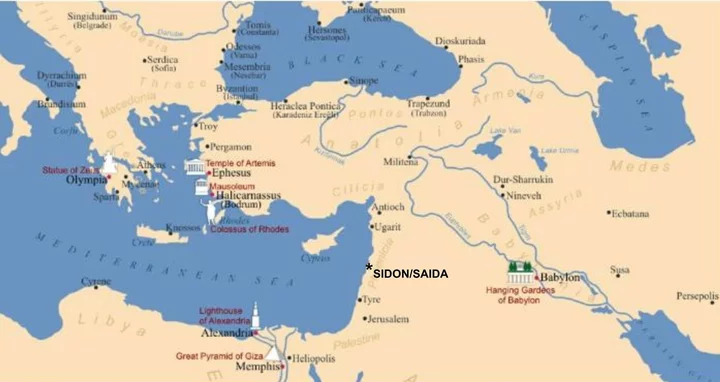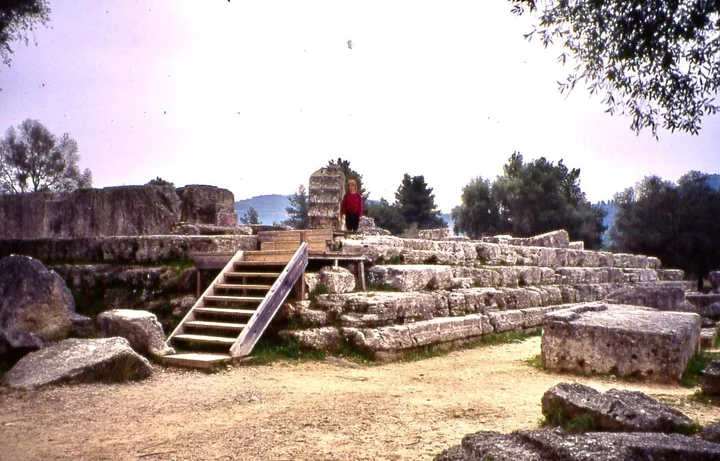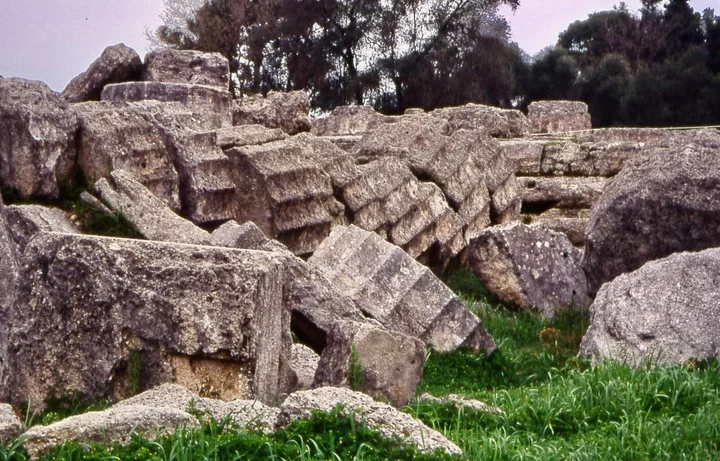I have gazed on the walls of impregnable Babylon, along which chariots may race, and on the Zeus by the banks of the Alphaeus. I have seen the Hanging Gardens and the Colossus of Helios, the great man-made mountains of the lofty pyramids, and the gigantic tomb of Mausolus. But when I saw the sacred house of Artemis that towers to the clouds, the others were placed in the shade, for the sun himself has never looked upon its equal outside Olympus.
I’ve written about, and visited (one from a distance) the sites of the Seven Wonders of the Ancient World, seven monuments designated about 130 BC by the Greek poet Antipater as worthy of special note. We know of Antipater’s original list from his writing, above. His compilation is close enough to our “official” list that we can safely date the seven wonders of the ancient world at least back to Antipater. Later the walls of Babylon were dropped in favor of the lighthouse at Alexandria. The final list includes three tombs, a palace, two statues and a lighthouse. Only one of these survives, ironically the first to be built. The wonders were, in order of, and with approximate dates of, construction:
- Pyramid of Cheops at Giza, 2600 B.C.
- Hanging Gardens of Babylon, 605-562 B.C.
- Statue of Zeus at Olympia, 470-462 B.C.
- Temple of Artemis at Ephesus, 356 B.C.
- Mausoleum at Halicarnassus, 353 B.C.
- Statue of Helios at Rhodes, 292-280 B.C.
- Pharos (lighthouse) of Alexandria, 247 B.C.
Location of the Seven Wonders of the Ancient World (Unknown + author)
Antipater was from Sidon on the Lebanese coast. Today it’s known as Saida, located at the westerly end of the Trans-Arabian oil pipeline. Sidon was about at the center of the seven sites. The farthest west wonder is at Olympia (statue of Zeus) and the farthest east in Babylon (Hanging Gardens), about 1400 miles apart. The seven locations pretty well delineate that part of the known world then considered important by the Greeks.
Remains of the temple that housed the (long-lost) statue of Zeus at Olympia, created by Pheidias, sculptor of Athena in the Parthenon. It was destroyed by fire in AD 475. (Barry Evans)
Statue of Mausolus (hence “Mausoleum”) now in the British Museum. (Barry Evans)
So: Why seven? Why not four or five or ten? After all, there are four points to the compass, and we have five fingers on each hand. Fact is, seven appears to have been a special, if not mystical, number since time immemorial. Consider, for instance, how often seven appears in classical literature and theological teachings:
- The Bible contains over 400 references to the number seven, starting with seven days of creation
- A Menorah has seven branches
- In both the Jewish (Kabbalah) and Muslim teachings, God dwells in the farthest of the spheres, the Seventh Heaven
- The Seven Sisters, daughters of Atlas, who are immortalized in the Pleiades star cluster
- The two most prominent constellations seen from the northern hemisphere, Ursa Major (“Big Dipper”) and Orion both have seven bright stars
- The “Seven against Thebes” were seven heroes who made war on the king of Thebes, according to Aeschylus’ play
- The Seven Sleepers of Ephesus were legendary martyrs immured in a cave near Ephesus. Upon awakening 200 years later, they convinced the emperor Theodosius II to embrace Christianity
- In oriental tradition, there are Seven Gods of Luck (not to mention Seven Samurai, a movie remade in the U.S. as The Magnificent Seven)
- Rome was founded on Seven Hills
- We have seven each: virtues, sages, purple passions, deadly sins, Pillars of Wisdom, and bodily orifices (I have, anyway);
- Of the 11 possible sums from a pair of rolled dice, seven is more likely than any other number to be the sum of the spots. (Ask anyone who’s played Monopoly or craps.)
And would you believe that every seven days, LoCO publishes this column…coincidence? I think not.




CLICK TO MANAGE